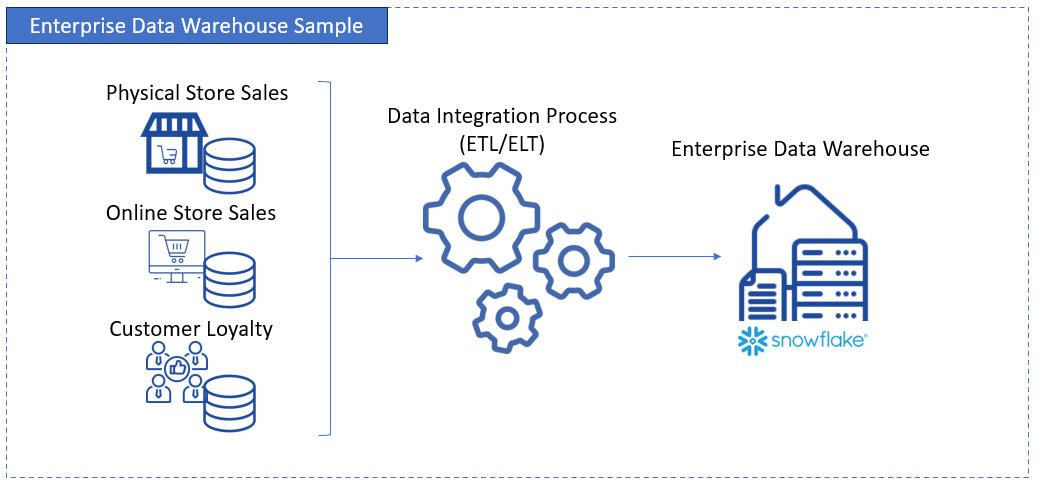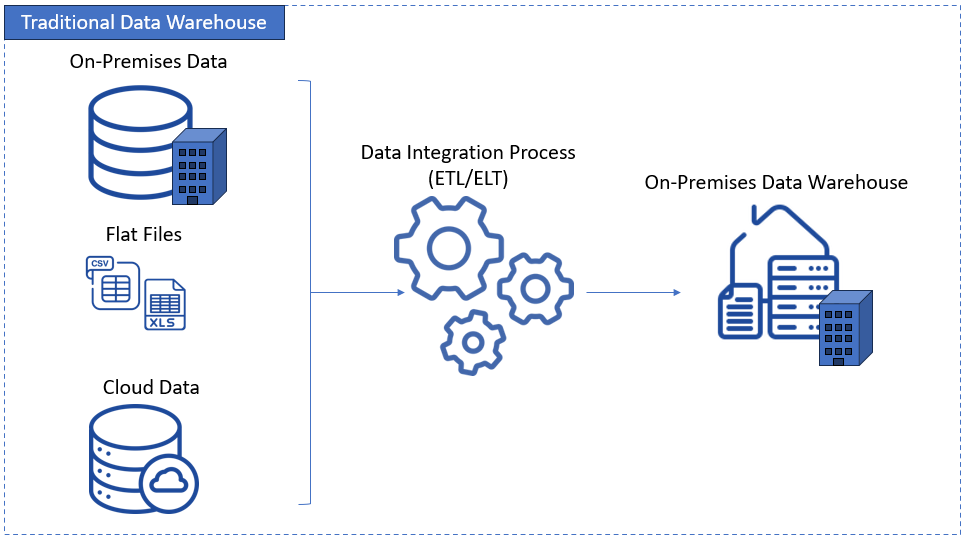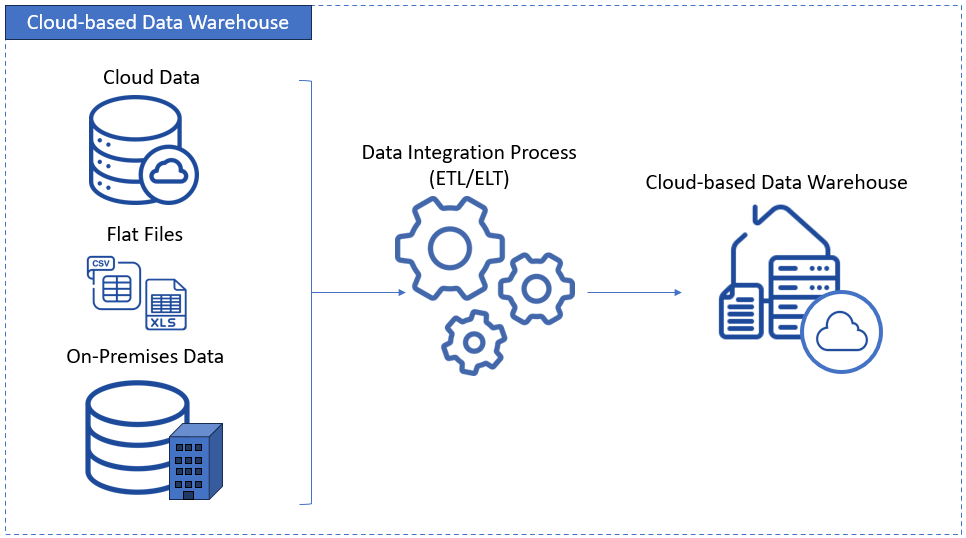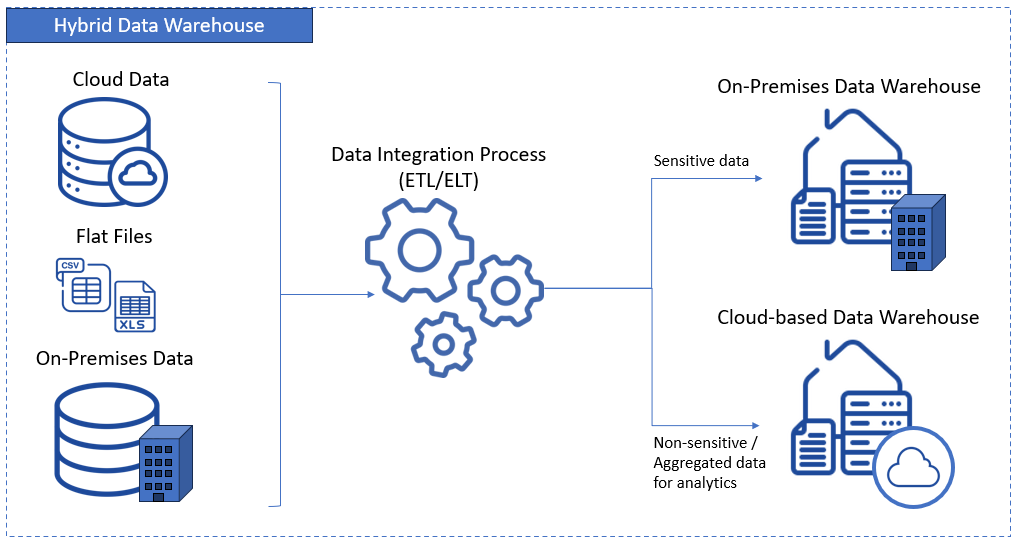An Enterprise Data Warehouse (EDW) is a modern, scalable, centralized repository that integrates data from multiple systems across an organization. It gathers and combines data from business systems such as ERP, CRM, and HR systems. EDW organizes data for a unified platform ready for enterprise analytics and reporting.
With an EDW, businesses can analyze structured, semi-structured, or unstructured data to uncover actionable insights. This allows advanced analytics to help improve an organization’s services.
This article will discuss EDW key features, types, and benefits. It will also provide steps to build an EDW, the best practices, and future trends.
What is an Enterprise Data Warehouse?
An Enterprise Data Warehouse stores and organizes data from diverse systems across an entire organization. EDW includes data types such as:
- Structured data: data from relational databases and systems such as ERP, sales, and more.
- Semi-structured data: data from JSON and XML files, and the like.
- Unstructured data: data from images, videos, and documents.
An EDW functions as a hub for analytics, comprehensive reporting, and data-driven decision-making.
The global data warehousing market is projected to increase by $59.05 billion by 2028. Real-time data analytics, edge computing, and multi-cloud data warehousing solutions influence the increasing demand.
Differences Between Enterprise Data Warehouse, Traditional Data Warehouse, and Operational Databases
An Enterprise Data Warehouse differs from traditional data warehouse and operational databases. Check out the comparison table below:
| Feature/Criteria | Enterprise Data Warehouse (EDW) | Traditional Data Warehouse (DW) | Operational Databases |
|---|---|---|---|
| Primary Function | Enterprise-wide analytics and reporting | Structured analytics | Daily transactional processing |
| Data Types | Structured, semi-structured, unstructured | Primarily structured | Structured only |
| Scalability | Elastic, cloud-based | Fixed, hardware-bound | Limited to transactional needs |
| Real-time Data Support | Available | Limited | Available for transctions, not for analytics |
| AI/ML Compatibility | Built-in | Minimal | Not applicable |
| Deployment Model | Cloud-native or hybrid | Typically on-premises | Typically on-premises |
| Example | Combined ERP, CRM, and Helpdesk data for AI/ML processing | Sales data of a business unit for analysis | Daily sales data stored in a relational, SQL database |
Key Takeaways:
- Both EDW and DW are for analysis, but EDW focuses on a bigger, enterprise-wide analysis suitable for Artificial Intelligence (AI) and Machine Learning (ML).
- Operational databases store daily transactions and collect data for a specific system. Data warehouses, including EDW, gather data from these operational databases and unify them.
Enterprise Data Warehouse’s Role in Enterprise Data Strategies
Enterprise Data Warehouses have key roles in an organization’s data strategies, namely:
- Centralized Data Storage: Consolidation of siloed data from multiple business units into a unified platform ensuring consistency and reliability.
- Enhanced Analytics Capabilities: Empowering organizations with tools for predictive analytics, KPI tracking, and machine learning.
- Support for Enterprise Growth: EDW Scalable architecture accommodates growing data volumes to ensure long-term viability.
Key Features of an Enterprise Data Warehouse
The following key features represent Enterprise Data Warehouse:
Centralized Data Repository
This is the backbone of data warehouses whether traditional or enterprise. All diverse data sources of an organization ranging from databases, flat files, API, and more, go to this central repository. It becomes a single system as a source for dashboards, reports, and more.
Benefits of a unified repository include:
- Reduced duplication and data silos that are common in enterprises.
- Simplified data governance and consistent view of key data entities.
Example: A retail chain consolidates data from store transactions, online sales, and customer loyalty systems. See a sample diagram from these systems flowing into a Snowflake Enterprise Data Warehouse below:

Scalability
Scalability pertains to handling growing load and demand without affecting performance. Enterprise Data Warehouses are capable of adjusting compute and storage resources on demand. Traditional data warehouses suffer from scalability issues. A costly solution is to upgrade its hardware and software.
Example: Snowflake has multi-cluster data warehouses. It allows an organization to define a fixed number of clusters. Then they can maximize or auto-scale them when needed. This way, it can handle the increasing number of users running large queries for reports.
High Performance
EDWs can do in-memory query processing to improve performance and achieve near real-time analytics. But note that performance starts with a good data warehouse structural design. No matter how good the platform is, queries will run slow if the structural design is bad.
Example: One benchmark test of a SnowFlake EDW having about 60 million rows took only 2.5 seconds.
It is best to compare EDW solutions to see which scales and performs best for your demands. Organizations that consider this early will be ready for an event like Black Friday sales when transactions are at their peak.
Integration
Business Intelligence tools can connect to EDWs through native connectors or standard libraries. Connecting through Power BI or Tableau will be easy. Many data integration platforms can also interact with EDWs to ensure an updated and accurate warehouse.
Example: A retailer forecasts trends based on purchase history and customer behavior in Azure Synapse.
Real-Time Analytics
An Enterprise Data Warehouse can process streaming data and provide immediate results. With real-time processing, businesses can react quickly to detect anomalies or adjust a problematic situation.
Example: Fraud detection in credit card transactions.
AI/ML Tools
Various cloud providers offer Machine Learning and AI capabilities built into their EDW. ML frameworks like TensorFlow are available in Google BigQuery for predictive analytics.
Example: Predictive maintenance in manufacturing using a BigQuery EDW as the data source.
Big Data Platforms
EDWs are capable of processing massive data lakes through Hadoop and Spark. These technologies enable an organization to handle high-volume, high-velocity, and diverse data types.
Massive data lake integration with EDWs ensures schema changes are not so expensive.
Example: A retailer wants to analyze customer shopping behavior. This will improve product recommendations and optimize inventory. They manage a massive volume of data stored in Azure Data Lake. These were consolidated in a SnowFlake Data Warehouse. Spark processes the data for Clickstream and Sentiment analysis.
Data Security
EDWs have features like end-to-end encryption, data masking, and role-based access control. The cloud hosting providers where EDWs are housed also offer IP filtering and other security measures to avoid unauthorized access.
Example: A financial company’s C-executives access high-level enterprise reports on income, expenses, and KPIs. Meanwhile, marketing, finance, and operation staff use a different view for their reports.
Compliance
Cloud providers like Microsoft, Google, and Amazon align their cloud services, including EDWs, with industry standards like GDPR (data privacy) and HIPAA (healthcare).
IBM’s Cost of a Data Breach Report for 2024 highlights the importance of security and compliance because the global average cost is USD 4.88 million, a 10% increase over 2023.
Types of Data Warehouse Architectures
Data warehouse architectures define how data is stored, accessed, and managed. Enterprises can choose among three primary architectures. Their choice depends on their operational needs, budget, and data strategy. These architectures are described below:
Traditional On-Premises Data Warehouses
Traditional data warehouses are typically on-premises and have the following features:
- Fixed infrastructure housed within an enterprise’s facilities. A company maintains the servers with skilled staff.
- Designed for structured data with robust schema requirements.
- Uses relational databases optimized for OLAP (e.g., Teradata, Oracle).
This setup has pros and cons. Check them out below:
Pros:
- Data Control: Full control over storage, security, and processing.
- Customization: Tailored to specific business needs.
- Reliability: Not dependent on internet connectivity.
Cons:
- High Costs: Expensive hardware, maintenance, and upgrades.
- Scalability Challenges: Limited by hardware capacity.
- Slow Deployment: Adding new features or scaling is time-consuming.
Below is a diagram for consolidating various data sources into an on-premises data warehouse:

Example: Teradata’s on-premises solutions are known for large-scale analytics. Yet, it needs significant IT investment. However, regulations may dictate sensitive data to stay on-premises. So, this setup will work for that scenario.
Cloud-Based Data Warehouses
Cloud data warehouses are outside of company infrastructure. The following are their features:
- A cloud data warehouse is fully hosted on platforms like AWS, Azure, or Google Cloud Platform.
- Offers pay-as-you-go pricing and elastic scalability.
- Optimized for modern data, including semi-structured formats like JSON and Parquet.
Like traditional ones, they have pros and cons worth noting. See them below:
Pros:
- Cost-Effectiveness: Eliminates upfront infrastructure costs.
- Scalability: Seamlessly handles large, dynamic data volumes.
- Accessibility: Enables global access with minimal downtime.
Cons:
- Dependency on Connectivity: Requires stable internet for optimal performance.
- Security Concerns: Relies on the cloud provider’s security measures.
- Potential for Vendor Lock-In: Moving to another platform may be complex.
Below is a diagram for consolidating various sources into a cloud-based data warehouse:

Example: Snowflake’s cloud-native architecture separates compute and storage. So, it delivers high-performance analytics without manual tuning.
Hybrid Data Warehouses
This setup works for scenarios where sensitive data should stay on-premises as dictated by regulations. The rest of the data are summarized and stored in the cloud. A unified query system that works for both data warehouses will make querying easier. Mechanisms like caching will speed up the query process.
They have the following features:
- Combines on-premises systems with cloud infrastructure.
- Allows enterprises to keep sensitive data on-premises while leveraging cloud benefits for scalability and analytics.
- Best suited for gradual cloud transitions.
There are also pros and cons in this setup listed below:
Pros:
- Flexibility: Tailors workloads to business requirements.
- Cost Savings: Uses the cloud for high-volume or temporary tasks.
- Compliance: Meets regulatory requirements by keeping critical data in-house.
Cons:
- Complexity: Managing both environments can be challenging.
- Integration Issues: Ensuring smooth data synchronization requires robust systems.
- Cost Management: This can be costly if not optimized.
The following is a diagram for consolidating multiple data sources into two data warehouses, one on-premises and another, a cloud-based one.

Example: Azure Synapse integrates on-premises and cloud components, making it ideal for hybrid strategies.
Comparison Table
Below is the summary of the different types of data warehouse architectures:
| Aspect | On-Premises DW | Cloud-Based DW | Hybrid DW |
|---|---|---|---|
| Cost | High upfront and maintenance costs | Pay-as-you-go, cost-efficient | Moderate, depends on usage |
| Scalability | Limited by hardware | Virtually unlimited | Moderate, cloud-dependent |
| Security | Full enterprise control | Dependent on cloud provider | Combines enterprise control and provider’s security |
| Performance | High for predictable workloads | Elastic for dynamic workloads | Balanced |
| Implementation | Time-intensive | Quick setup and deployment | Gradual |
Benefits of an Enterprise Data Warehouse
An Enterprise Data Warehouse is more than a data storage system for combined data sources. It is also a powerhouse for transforming these data into actionable insights. Smarter decisions, staying compliant, and being efficient are the fruits of EDW efforts.
Consider the specific benefits of an Enterprise Data Warehouse to any organization below:
Improved Data Accessibility and Reliability
Businesses benefit from accurate data generated near real-time. This ensures that decision-makers access a single source of truth that is consistent, accurate, and up-to-date.
Cloud providers deliver assured uptime and availability for accessing their EDWs. They offer redundancy and fault tolerance. This ensures critical data can be accessed reliably for decision-making.
Example: A retail chain uses an EDW to combine sales data from multiple stores in real-time. This enables them to quickly adjust their inventory. Their EDW has an assured uptime and availability of 99.99% to ensure data is always available for decision-making.
Enhanced Business Intelligence and Reporting
EDWs excel in generating insights faster than traditional ones. They are friendly with BI tools like Tableau, Power BI, or Looker. This accelerates the visualization and reporting process. Enterprises can track KPIs and spot trends with minimal or zero delays.
EDWs empower enterprises to perform advanced analytics, such as predictive modeling or customer segmentation, directly on consolidated datasets. This improves decision-making.
Example: A financial firm leverages an EDW to create dashboards for portfolio performance, reducing manual reporting time by 60%. This also ensures timely decisions on critical issues.
Regulatory Compliance and Risk Mitigation
Security and compliance are important. That’s why EDWs have secure storage by default. They support features like encryption and role-based access control. That way, sensitive information stays protected.
EDWs also keep detailed logs and metadata. This simplifies regulatory audits and reduces the risk of non-compliance penalties.
Example: A healthcare provider uses an EDW to securely store patient data while complying with HIPAA regulations.
Cost Savings in the Long Run
EDWs aim to remove data silos and save on operational costs in the long run. By consolidating data from multiple silos, EDWs reduce duplication, data storage costs, and the need for individual system maintenance.
Cloud-based EDWs, in particular, minimize hardware investments and auto-scale on demand. This leads to cost-effective data management.
Future-Proofing Data Strategies
As business requirements change, modern EDWs expand to handle larger datasets, new data types, and more users without too much rearchitecting. They provide the foundation for adopting emerging technologies. This includes AI/ML, IoT analytics, and big data platforms. This allows organizations to remain competitive and their data secured and future-proofed.
Example: A logistics company expands its EDW to include IoT data from delivery vehicles for better route optimization.
How to Build an Enterprise Data Warehouse
Building an EDW is a strategic journey. It requires clear goals, the right tools, and careful planning. The following is a high-level guide to simplify the process and maximize success.
Define Business Objectives
Answer the Question: “Why Build an EDW?” Primary goals can be introducing or improving analytics, unifying siloed systems, or complying with regulations. Align these goals with enterprise-wide strategies to ensure ROI.
Example: A global retail chain aims to consolidate sales, customer, and inventory data into a single platform to enable faster decision-making.
Key Tip: Involve stakeholders early (CIOs, data architects, and department heads) to identify pain points and set measurable outcomes. Elect a project sponsor to ensure everything is in order and to minimize resistance.
Select the Right Architecture and Tools
Choosing the architecture and tools should consider the following factors:
- Scalability: Can the system grow with your data needs?
- Compatibility: Does it integrate with existing systems like Salesforce or QuickBooks?
- Cost: Compare subscription-based cloud solutions versus upfront investments on-premises.
The following are popular platforms to consider depending on the chosen architecture:
- Cloud: Snowflake, Google BigQuery, AWS Redshift.
- Hybrid: Microsoft Azure Synapse Analytics.
- On-Premises: Teradata, Oracle.
Key Tip: Use free trials or pilot programs to test compatibility with your existing infrastructure.
Develop a Data Integration Plan
Identify and prioritize data sources — ERP systems, CRM platforms, IoT devices, or external APIs. Integrating all data sources in one data integration project will take longer and is not advisable. Changes in one or more data sources will affect the entire integration project. Dividing the project into phases is more manageable.
Then, extract data from sources, transform it into a usable format, and load it into the EDW (ETL). Alternatively, in modern setups (ELT), raw data is loaded first, and transformations happen within the EDW. Use tools like Skyvia, Talend, or Informatica for automation.
Example: A retail company chooses to integrate CRM data sources into the EDW. This will allow them to make better decisions for their customers and improve marketing. Their ERP data source will follow after a successful phase 1 integration.
Key Tip: Use an agile approach to evolve the Enterprise Data Warehouse. Start with high-value data that impacts core KPIs to showcase early wins.
Migrate and Validate Data
Implement the integration plan. Move existing datasets incrementally, starting with non-critical data to test the process. Use parallel testing to ensure new data pipelines function correctly.
Implement tools like Apache Griffin to cleanse, validate, and deduplicate data before it reaches the EDW.
Optimize for Performance
After a successful initial integration to the Enterprise Data Warehouse, performance issues may arise. Businesses can fine-tune the EDW through indexing and partitioning. Organize data into smaller, more efficient segments to speed up query execution (partitioning). Table indexes ensure queries with specific criteria will return results faster.
Further query optimization includes caching and materialized views for recurring analytical tasks. Adjustments like auto-scaling compute and storage resources can also be added to anticipate increases in data volumes.
Then, monitor the EDW health and performance using monitoring tools to detect bottlenecks.
Example: Snowflake’s auto-scaling compute resources dynamically adjust to handle spikes in query demand.
Train Stakeholders
All stakeholders need training to use the EDW effectively. Ensure IT teams, analysts, and business users are equipped to manage and utilize the EDW. Focus areas include:
- Technical training for IT staff on system architecture and data pipelines.
- Analytical training for business users to leverage BI tools and dashboards.
Key Tip: Partner with vendors or third-party consultants for in-depth onboarding sessions.
Best Practices for Managing an Enterprise Data Warehouse
An Enterprise Data Warehouse needs ongoing care to ensure it continues to deliver value. These best practices can help optimize performance, maintain security, and align with evolving business needs. The following best practices for data warehousing are described below:
Data Governance and Security
A lack of governance can lead to data quality issues, breaches, and regulatory fines. The following are the best practices in data governance and security:
- Implement role-based access controls to limit data access based on user roles.
- Use encryption for data at rest and in transit.
- Establish data stewardship roles to ensure data accuracy and consistency.
Example: Snowflake provides built-in governance features like dynamic data masking to protect sensitive information.
Key Tip: Regularly audit data access logs to identify and mitigate potential vulnerabilities.
Regular Maintenance and Updates
An outdated EDW can become inefficient, incompatible with new tools, and prone to errors. Below are the best practices in this area:
- Schedule periodic updates to incorporate software patches and new features.
- Perform routine performance tests to identify and resolve bottlenecks.
- Monitor storage utilization and scale resources as needed.
Key Tip: Use downtime windows for maintenance to minimize disruptions.
Collaboration Between IT and Business Teams
Misalignment can lead to technical implementations that fail to meet business needs. Check out the best practices in collaboration on implementing EDWs:
- Host regular meetings between IT and business analysts to review EDW goals and usage.
- Create shared dashboards to visualize data in a way that’s meaningful to both teams.
- Encourage cross-training to bridge the knowledge gap between technical and non-technical stakeholders.
Example: Retail enterprises often have teams collaborate to ensure inventory and sales data align with supply chain strategies.
Key Tip: Develop a shared glossary of data terms to prevent misunderstandings.
Monitor Performance Metrics
Performance KPIs ensure the EDW remains efficient and delivers accurate insights. Best practices in this area include:
- Use metrics like query response times, load times, and data freshness to measure performance.
- Implement automated monitoring tools like Snowflake’s Resource Monitors or Google BigQuery’s Performance Insights.
- Set thresholds for alerts to address potential issues proactively.
Key Tip: Benchmark your EDW against industry standards to identify areas for improvement.
Document Changes and Processes
Without documentation, teams risk losing knowledge during transitions or scaling efforts. The following are the best practices in this area:
- Maintain a version-controlled repository for all changes to the EDW schema, ETL pipelines, and access policies.
- Document key workflows and troubleshooting guides for easy reference.
- Record business decisions that influence the EDW’s structure for context.
Example: Teams using Git for code repositories often extend it to maintain EDW configurations and scripts.
Key Tip: Review and update documentation during major updates or migrations.
Trends and Future of Enterprise Data Warehousing
The world of enterprise data warehousing (EDW) is evolving rapidly. It is driven by advancements in technology and shifting business needs. The following are the trends shaping its future and how enterprises can adapt.
AI and Machine Learning Integration
AI and ML are revolutionizing data processing by enabling predictive and prescriptive analytics. EDWs are evolving to support these advanced models by offering robust computational capabilities.
Key Tip: Enterprises should integrate AI-ready frameworks into their EDW to remain competitive.
Examples:
- AI in Action: Retail companies use ML models trained on EDW data to forecast demand and optimize inventory.
- Platforms like Snowflake now support integrated AI/ML pipelines through partnerships with tools like DataRobot and SageMaker.
The Rise of Real-Time Data Warehousing
Businesses need immediate insights to make agile decisions. Real-time data warehousing provides near-instantaneous access to actionable data.
Challenges: Real-time data requires robust architectures to handle the velocity and ensure data accuracy.
Examples:
- Use cases in finance include fraud detection systems that analyze transactions in real time.
- Tools like Google BigQuery and Azure Synapse offer real-time streaming capabilities.
Cloud-Native Enterprise Data Warehouse and Serverless Architectures
Cloud-native EDWs are reducing the need for traditional infrastructure. It makes data warehousing more cost-efficient and scalable. Serverless architectures further simplify operations by automating resource management.
Implications: These advancements lower operational overhead while improving performance and adaptability.
Examples:
- Snowflake’s separation of storage and compute aligns with serverless principles, enabling elastic scaling.
- AWS Redshift’s RA3 nodes allow users to scale compute independently of storage.
Sustainability Initiatives in Data Management
Sustainability initiatives are growing. As environmental concerns increase, data centers and EDWs are adopting energy-efficient practices to reduce carbon footprints.
Best Practice: Opt for cloud providers with renewable energy commitments to align EDW practices with sustainability goals.
Examples:
- Google Cloud’s carbon-neutral services support enterprises in achieving sustainability goals.
- Some data platforms now offer dashboards that track the environmental impact of queries and storage.
Potential Challenges and Solutions
With rapid technological advances, balancing innovation with security and compliance is crucial. Below is the innovation vs. security challenge:
Challenge: AI-powered EDWs may expose vulnerabilities due to automated processes.
Solution: Use tools like Snowflake’s Secure Data Sharing or Azure’s Defender for SQL to enhance protection.
There are also pressures on businesses regarding compliance:
Challenge: Enterprises must stay compliant with evolving regulations like GDPR and CCPA while leveraging cutting-edge technologies.
Solution: Integrate compliance monitoring tools directly into the EDW.
Conclusion
An Enterprise Data Warehouse empowers companies to make data-driven decisions with confidence. By centralizing diverse data sources, companies reduce data silos and ensure consistent information in their reports. It enables them to embrace advanced analytics without sacrificing security and compliance.
Start today by evaluating your company’s current data management setup. Then follow the steps in building an EDW and adhere to best practices outlined in this article. It could be your company’s next innovation to stay competitive and serve your customers better.